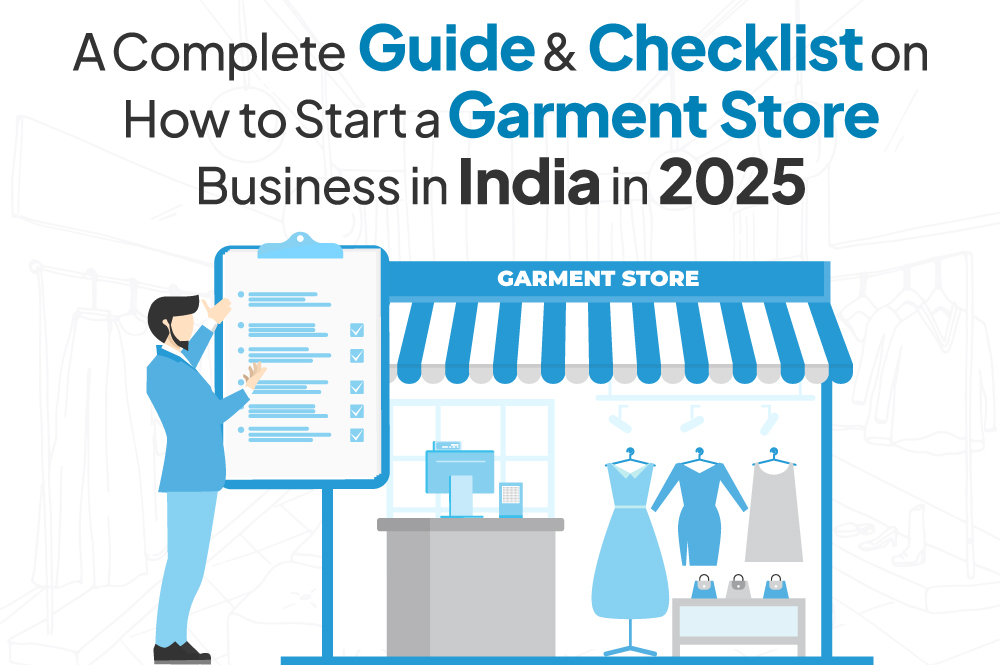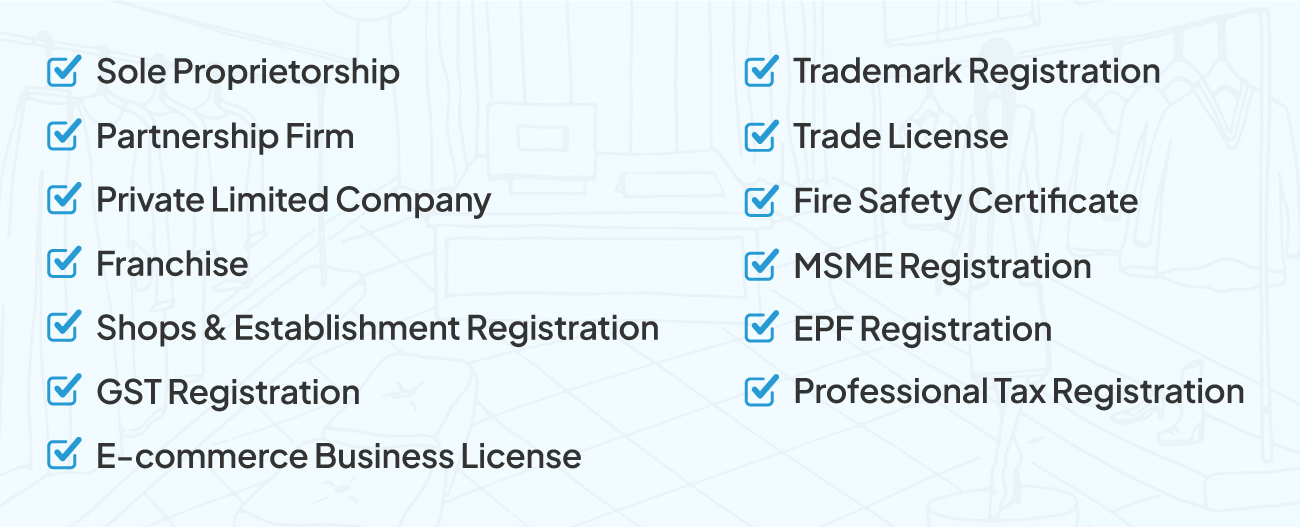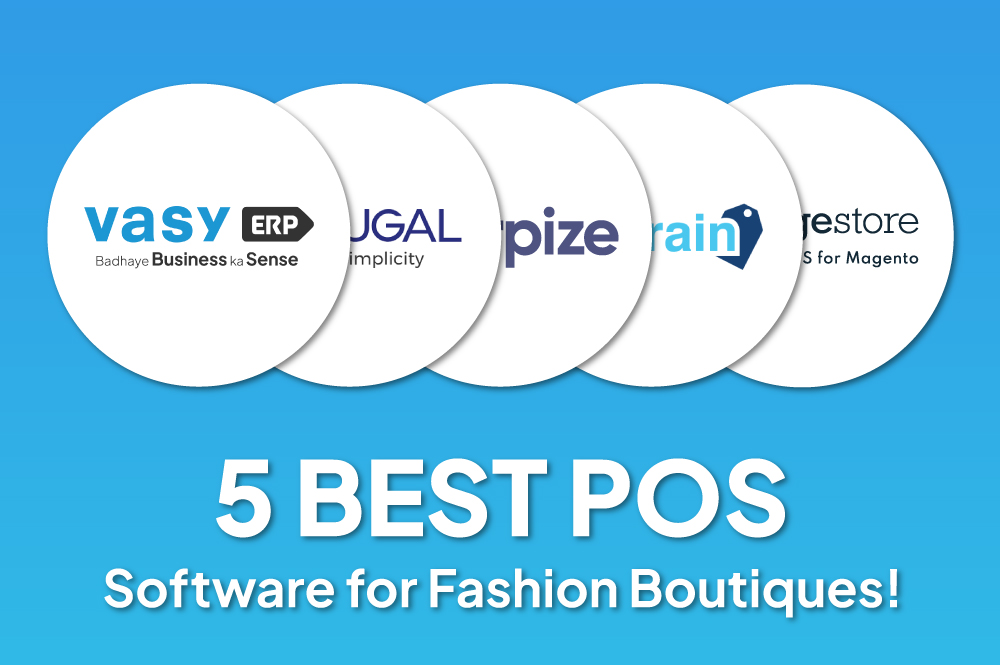A Complete Guide and Checklist on How to Start a Garment Store Business in India in 2025
January 1, 2025

Ever walked past a boutique window or garment store and dreamt of having your very own clothing business? Those trendy stores filled with gorgeous pieces can be seriously inspiring. However, launching a clothing store might overwhelm you. You have to take business registrations, comply with local administrative regulations, find a suitable location for opening your readymade garment store, and also find suppliers for your garment inventory requirements.
From juggling finances to keeping track of inventory, from dealing with cash registers to customers, it’s easy to mess things up. And to be honest – if you’re starting from scratch you can easily miss out on important details.
Therefore, it is advisable to go step-by-step to make things much smoother. To help you out, we’ve put together a detailed guide filled with everything you need to know about starting your garment business in India.
This article covers all the necessary steps to start a readymade garment store in India. It includes a checklist for how to find the location for establishing your stores, key business registration documentation required, operational requirements, standard procedures, inventory requirements, and software applications needed to run the store efficiently. Let’s explore how to start a garment store business in India in 2025.

If you are planning to enter the fashion industry, you may be wondering whether it is worthwhile to open a readymade apparel boutique in India.
Let us clear this confusion of yours.
Did you know the Indian apparel industry is expected to reach a whopping $190 billion by 2025-26? That’s a giant market waiting to be tapped into! The immense growth of clothing fashion startups like Bewakoof.com, Tata CLiQ, Zivame, Clovia, and many more, in recent years is the witness of apparel industry’s positive prospects. The garment industry has long been India’s main economic driver.
Now that we know the promising outlook that our garment industry has for small clothing businesses, let’s get into the essence of starting one.
Before opening your shop doors, take some time to understand your market. This means learning about the local people you want to sell to. What is their persona? What kind of clothes do they like? When and how do they usually shop? By understanding your target audience, you will find your niche. This will help you to stock the right clothes and brands within the correct price range and create a shopping experience they’ll enjoy.
After getting a feel of your target market, get to know your competition. Research other garment stores in your area: what do they sell? What clothing styles are they offering? What are their strengths and shortcomings? This will help you determine your unique selling points. All the things that make your store special and different from the others.
A detailed business plan is like that map for your readymade garment store. It lays out your goals and shows how you’ll get there. Here’s what to include:
A strong business plan is key for getting loans or attracting investors for your clothing business:
Personal Investment: A business plan will help you know how much you need to invest if you are investing your own money or savings.
Loans: It helps you to convince banks to lend you money. A good plan shows them you’re not just winging it, you have a real plan to make your business successful. This makes them feel more comfortable giving you a loan.
Investors/Partners: A strong plan shows your vision which attracts investors or partners with money! It shows them exactly why your business is a great opportunity. It explains your awesome ideas, how you’ll make money, and how they’ll eventually get their money back (with a profit!).

Now comes the legal part, in this section, we will discuss some of the common but must-have government formalities that you will need for your store. Before starting the store, you must have proper business registration, local administrative licenses and permits.
Get your business registered as a suitable entity like:
Finding a perfect location for your garment store can significantly influence your business. Determine the market potential of your target area. The location should be selected after a market survey. Select a heavily populated location with a strong profit potential. High foot traffic and low competition are needed at the suggested location. Sales of physical stores are primarily driven by foot traffic. Make sure there is enough pedestrian traffic and that too of your target demographic.
Layout Suggestions:
Finding the right people to get your clothes from is like having good partners in your business. You want reliable people who deliver high-quality clothes, just like you promise to your customers. Determine the types of garments you need, including styles, sizes, materials, and quantities. Set clear quality standards for the fabrics, stitching, and finishing. Take your time to research different suppliers and their supply areas.
You can also attend trade shows, visit local markets, or join online groups to find your ideal supplier. Consider local suppliers for faster turnaround times. Check their business history and customer testimonials.
Choosing the right clothes to sell is like making a perfect wardrobe. You want to have popular items that everyone loves but also add your own unique touch. Look at what other stores sell and see what people in your area are wearing. This will help you understand what’s trendy and in demand. For example, if you’re targeting young women, consider stocking trendy dresses, statement tops, and comfortable jeans alongside timeless staples.
| Category | Men’s Wear | Women’s Wear | Kids’ Wear | Sports Wear |
| Tops | T-Shirts Polo Shirts Dress Shirts Casual Shirts Hoodies Sweaters | Sarees Blouses T-Shirts Tank Tops Sweaters Hoodies Tunics | T-Shirts Polo Shirts Casual Shirts Hoodies Sweaters | Sports Bras Gym Tops Sports Shirts |
| Bottoms | Jeans Dress Pants Shorts Sweatpants | Jeans Leggings Skirts Shorts Trousers Sweatpants | Jeans Pants Shorts Skirts Sweatpants Leggings | Sports Shorts Gym Leggings Sports Shorts |
| Outwear | Jackets Blazers Coats Vests | Jackets Coats Blazers Cardigans | Jackets Coats Raincoats | Tracksuits |
| Suits | Business Suits Casual Suits Formal Suits | Maxi Dresses Casual Dresses Evening Dresses Cocktail Dresses | Casual Dresses Party Dresses Rompers | NA |
| Under Garments | Boxers Briefs | Bras Panties Shapewear | Underwear Vest | Athletic Boxers Supporter |
| Night Wear | Pajamas Robes Nightshirts | Nightgowns Pajamas Robes | Pajamas Nightgowns Onesies | NA |
If you use a garment store software like VasyERP, it tells you your least and best-selling products. This way you can stock more products that are selling high.
Once you have your clothes and suppliers, it’s time to think about your shop itself. To present your clothes nicely and run your business smoothly, you’ll need two key things: Hardware & Software.
So, once your store is ready, it’s time to let people know about it!
Sure, you’ve got the racks, the mannequins, and the dream collection of clothes. But your trendy garment store needs more than just the basics. We know that effective management of store operations is not a child’s play. With so many things to manage and track at once, you need a robust Point-of-Sale system.
That’s where our One-stop POS Solution – VasyERP comes in!
It offers a comprehensive suite of features designed specifically for garment stores. From simplifying transactions to managing discounts and customer engagement. Transforming your daily inventory hassles into smooth offline and online store operations, VasyERP streamlines your garment store with an all-in-one system. The key features of VasyERP Garment store POS include inventory management, Billing and Invoicing, Barcoding, GST Compliant Accounting, CRM, Returns and Refund Management, Multi-store management, Warehouse management, Loyalty and Discount Management. Compatible with various hardware components like cash registers, barcode scanners, and receipt printers, VasyERP ensures seamless integration and high performance.
Starting a garment store business in India is a promising and potentially profitable venture, given the country’s diverse and vibrant fashion market. With thorough planning, dedication, and a strategic approach, a garment store business in India can thrive and achieve long-term success. This blog post equips you with a detailed checklist, giving you a clear roadmap to jumpstart your clothing venture. It gives essential steps like market research, business planning, legal requirements, and marketing strategies.
For customer satisfaction, optimal inventory management handling billing, and many more daily activities of your garment store, make sure you deploy quality garment store software. With careful planning, technological support, and a commitment to quality, you can surely thrive in the Indian Garment retail industry.

As a footwear retailer, you know how difficult it is to...
October 30, 2023

Fashion boutique store management comes with a lot of c...
June 4, 2024
